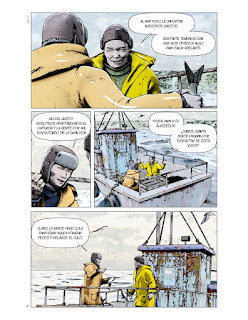Hola de nuevo.
Os presento el nuevo cómic en el que estoy ahora inmerso: Tres metros cúbicos.
La acción principal se enclava dentro de la contraofensiva ucraniana de Járkov que tuvo lugar en septiembre de 2022 y tiene como protagonistas a dos jóvenes rusos que, por distintas circunstancias, acaban inmersos en esta batalla. Esto da pie a un relato donde se abordan, entre otras, algunas cuestiones para la reflexión como: ¿Qué razones empujan a alguien a participar en una guerra? ¿valen la pena? ¿La guerra deshumaniza al soldado? ¿Los soldados actuales están preparados para afrontar nuevas armas como los drones?
De hecho, el título de ‘Tres metros cúbicos’ hace referencia al volumen de tierra que tiene como promedio una tumba humana. Porque a eso se reduce la intervención de una gran mayoría de participantes en estas contiendas. Muchos de ellos son empleados como carne de cañón en tácticas de dudosa eficacia y con frecuencia se ven desbordados por el empleo de las nuevas armas que los convierten en blancos fáciles.
Pero los cambios no se reducen sólo a la temática del cómic, sino también al flujo de trabajo y a las técnicas empleadas. Después de indagar entre la abundante información existente sobre técnicas de NPR en Blender y realizar bastantes pruebas, al final he decidido probar a realizar todo el trabajo de diseño/dibujo en Blender.
Mi intención en este nuevo proyecto es reducir el uso de Gimp e Inkscape al máximo (sólo edición de texturas e imágenes) y realizar por completo el diseño/dibujo de las viñetas en Blender. Evidentemente, el trabajo de maquetación y composición de las páginas continuo realizándolo en Scribus.
Sin embargo, integrar todo el trabajo de dibujo en Blender no implica necesariamente que se haya simplificado el proceso: es el resultado de una combinación de técnicas a nivel de shaders, composición de nodos, ‘Freestyle’ y ‘Grease Pencil’. Cada uno de los elementos que componen la escena (fondos, elementos, personajes y efectos) se encuentran en varias ‘Render layers’ a las que se aplica diferentes efectos o técnicas:
- En los fondos he intentado simular con el compositor de nodos los filtros de acuarela que antes realizaba con Gimp y GMIC.
- Los elementos secundarios simulan un filtro distinto (similar a la acuarela) que también está realizado con el compositor de nodos.
- Los personajes utilizan una combinación de ‘NPR shaders’ (color y tinta negra)integrados mediante composición de nodos y que son posteriormente retocados con ‘Grease Pencil’.
Uno de los mayores quebraderos de cabeza está siendo el empleo de las líneas de contorno y tinta negra. De momento, he optado por una combinación de varias técnicas: contornos y líneas integradas en shaders, ‘Freestyle’ y, sobre todo, ‘Grease Pencil’.
En este punto, quisiera agradecer a Sophie Jantak por sus estupendos videotutoriales sobre dibujo en ‘Grease Pencil’. Si me lees por aquí, quiero que sepas que eres una excelente artista y comunicadora y tus vídeos me han ayudado a aprender mucho sobre esta herramienta.
‘Grease Pencil’ permite simular trazos más naturales en el dibujo de una manera similar a lo que hacía en Inkscape, aunque todavía estoy en proceso de adaptación. De este modo, intento solventar algunas de las limitaciones que encuentro con la utilización de ‘Freestyle’. El inconveniente de este método de trabajo es que involucra una mayor cantidad de trabajo manual y, seguramente, su utilización sería menos eficiente en animación.
No me enrollo más, aquí tenéis las pruebas de las primeras páginas e intentaré ir subiendo actualizaciones. Espero que os guste el resultado.
Para el resto de páginas (el total ronda las 100), deseadme fuerza y mucha paciencia.
* If you are interested in an English version of this text, as well as the comic, you might want to visit this thread in the Blender Artists Community.









